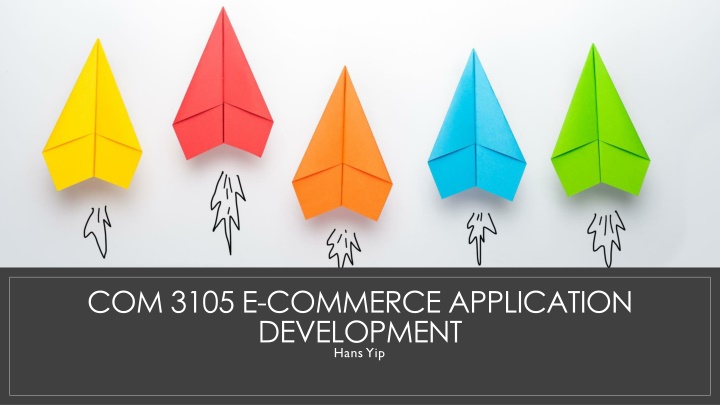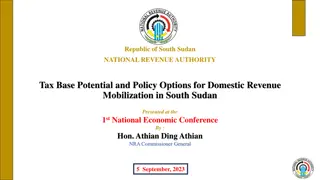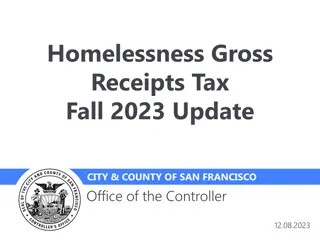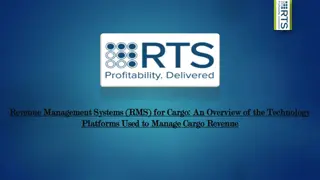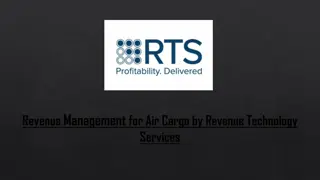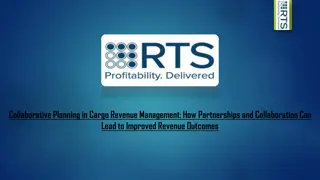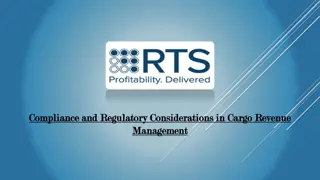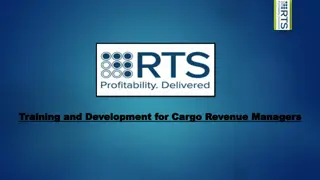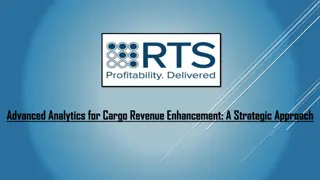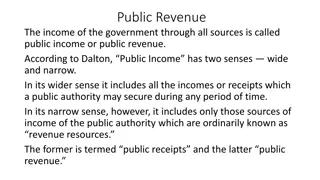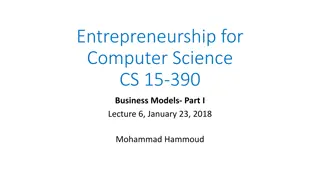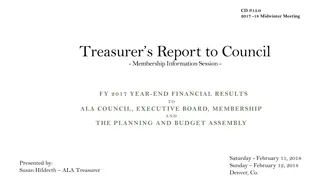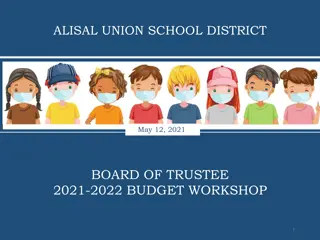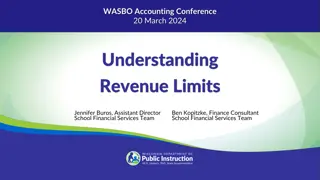Revenue Models for Online Business: Exploring Different Strategies
Learn about revenue models in e-commerce, including web catalogs, digital content, advertising-supported, fee-based, and fee-for-service models. Discover how companies leverage these models for both B2C and B2B online sales, examining the evolution from traditional mail-order catalogs to modern web-based approaches.
Download Presentation

Please find below an Image/Link to download the presentation.
The content on the website is provided AS IS for your information and personal use only. It may not be sold, licensed, or shared on other websites without obtaining consent from the author.If you encounter any issues during the download, it is possible that the publisher has removed the file from their server.
You are allowed to download the files provided on this website for personal or commercial use, subject to the condition that they are used lawfully. All files are the property of their respective owners.
The content on the website is provided AS IS for your information and personal use only. It may not be sold, licensed, or shared on other websites without obtaining consent from the author.
E N D
Presentation Transcript
COM 3105 E-COMMERCE APPLICATION DEVELOPMENT Hans Yip
Learning Objectives What a revenue model is and how companies use various revenue models What characteristics identify specific revenue models About revenue strategy choices that companies face when selling online How companies use the Web to connect with customers
Revenue Models for Online Business Not all electronic commerce initiatives have the goal of providing revenue; some are undertaken to reduce costs or improve customer service. (You will learn about those types in Chapter 5) In this chapter, you will learn about various models that online businesses currently use to generate revenue, including: Web catalog Digital content Advertising-supported (advertising-subscription mixed) Fee-based models Fee-for-transaction revenue models Fee-for-service revenue models These approaches can work for both business-to-consumer (B2C) and business-to-business (B2B) electronic commerce. Many companies create one Web site to handle both B2C and B2B sales. Even when companies create separate sites (or separate pages within one site), they often use the same revenue model for both types of sales.
1. Web Catalog Revenue Models In 1872, a traveling salesman Aaron Montgomery Ward started selling dry goods to farmers through a one-page list. In 1895, Richard Sears and Alvah Roebuck began mailing catalogs to farmers and small-town residents. By 1950, both Montgomery Ward and Sears, Roebuck & Company grew to become dominant retailers in the United States with retail stores serving urban markets and the catalog business well established in serving rural and small- town markets. In 1990, the general acceptance of the mail order catalog business built a solid base for the web-based version. For more than a century, catalog-based retail revenue model, called mail-order or catalog model, the seller establishes a brand image, and then uses the strength of that image to sell through printed information mailed to prospective buyers, who place orders by mail or telephone. In the twentieth century, successful mail-order businesses include: J.C. Penney, L.L. Bean, and Hickory Farms. Web catalog revenue model, many companies adapted the catalog model to the online world by replacing or supplementing their print catalogs with information on their Web sites.
1. Web Catalog Revenue Models Today, Customers place orders through the Web site, but in the early years of electronic commerce, many shoppers used the Web to obtain information about products and compare prices and features, and then made their purchases by telephones. B2B sellers have also been adopted the Web catalog model. Most of the successful Web catalog revenue model companies had already operating in the mail-order business and simply extended their operations to the Web. Other companies adopted the model after realizing that the products they sold in their physical stores could also be sold on the Web. This additional sales outlet did not require them to build additional stores, yet provided access to new customers throughout the world.
Discount Retailers: Getting a Great Deal Online In the first wave of electronic commerce, new discounters, such as Buy.com (now Rakuten), began their first retail operations online using the Web catalog revenue model. Borrowing the low-cost strategy used by traditional discount retailers (such as Costco, Kmart, and Walmart), these online businesses sell merchandise at extremely low prices. Most traditional discount retailers were reluctant to implement online sales at that time because they had huge investments in their physical stores and did not understand the world of online retailing. During the second wave of electronic commerce, these traditional discounters also adopted the Web catalog revenue model for their online sales efforts. They found online sales to be an important contributor to their overall revenues and profits.
Using Multiple Marketing Channels Having more than one way to reach customers is often a good idea for companies, as Montgomery Ward and Sears found out many years ago. They used one channel (retail stores) to reach urban customers and another channel (mail order catalog) to reach rural customers. Each different pathway to customers is called a marketing channel. Companies find that having several marketing channels lets them reach more customers at less cost. It is expensive to stock a large number of different items in a physical store, so Best Buy will stock the most popular items in its stores but will sell a wider variety of items on its Web site. Customers who want to have physical contact with a product can visit the retail store. A customer who wants a high- end and expensive home theater system can find it on the Web site. By having two marketing channels (retail store and Web site), Best Buy reaches more customers and offers more products than it could be using either channel alone. Using multiple marketing channels to reach the same set of customers can be an effective strategy for retailers. The following figure shows two examples of how retailers might combine two marketing channels.
COMBING MARKETING CHANNELS: TWO RETAILER EXAMPLES
Adding the Personal Touch Land s End pioneered the idea of online Web shopping assistance with its Land s End Live feature in 1999. Today, many Web sites offer a chat feature that is activated by the Web site visitor. Many sites activate a chat window when a visitor remains on a particular Web page longer than a certain time interval. In addition to text chat, some online retailers use video to communicate with customers. Many online clothing retailers offer personal shopper and virtual model features. The personal shopper is an intelligent agent program that learns the customer s preferences and makes suggestions. The virtual model is a graphic image built from customer measurements and descriptions on which customers can try clothes. The Canadian company that developed this Web site feature, My Virtual Model (virtual fitting rooms), has sold the technology to a number of other clothing retailers in which helps to increase in sales and decrease in returns. One problem that the Web presents for clothing retailers of all types is that the color settings on computer monitors vary widely. It is difficult for customers to get an accurate idea of what the product s color will look like. Most online clothing stores will send a fabric swatch on request. The swatch also gives the customer a sense of the fabric s texture - an added benefit not provided by catalogs.
2. Fee-for-Content Revenue Models Digital content revenue model, companies that sell rights to access the information they own. Many companies sell subscriptions that give customers the right to access all or a specified part of the information. Others sell the right to access individual items. A number of companies combine these two approaches and sell both subscriptions and individual access rights.
Legal, Academic, Business, and Technical Content LexisNexis offers a variety of information services for lawyers and law enforcement officials that include laws, regulations, court case decisions, public records, and legal treatises. In the past, law firms had to subscribe to and install expensive dedicated computer systems to obtain access to this information, but the Web has given LexisNexis customers much more flexibility in how they access their subscriptions. Many academic and professional organizations, such as the American Psychological Association and the Association for Computing Machinery, sell subscriptions to their journals online. Publishing online eliminates the high costs of paper, printing, and delivery, and makes dissemination of research results less expensive and more timely. Academic information aggregation services, such as ProQuest Dialog and EBSCO Information Services, purchases the rights to academic journals, newspapers, and other publications and resell those rights in various subscription packages to schools, libraries, companies, and not-for-profit institutions.
Electronic Books Companies such as Audible and Books-on-Tape (now both owned by Amazon) sold audio editions of books for many years, first as cassette tapes, then as CDs. Today, electronic books (that can be read or listened to) are available for dedicated devices such as Amazon s Kindle products. Electronic books are also sold as digital content by online stores such as Apple s iTunes and Google Play alongside digital music and video offerings. Sales grew rapidly starting in 2011 and have now declined to about 23% of total book sales in the U.S. but popularity growing in other countries. Physical and electronic books will likely coexist for many years to come.
Online Music The recording industry was slow to embrace online distribution of music because audio files are digital products that can be easily copied once purchased. The largest online music stores today include Amazon MP3, Apple s iTunes, and Google Play. Other companies, such as Pandora, Spotify, and Rhapsody offer subscription services that stream music to devices for a monthly fee rather than charging for specific songs or albums. To introduce potential customers to their services, some of these companies offer free, advertising-supported, limited versions of their subscriptions. Early complications No single store offers all music Individual stores promote their own music file formats Some artists/recording companies partner with specific store or boycott online sales altogether Some online music sellers required buyers to download and install software, called Digital Rights Management (DRM) software, that limited the number of copies that could be made of each audio file. In 2007, the Amazon MP3 store was the first offer DRM-free MP3 format. Since then, most other online music companies have come to offer their music in DRM-free, compatible file formats as well. After years of suffering declines due to illegal copying, the music industry in 2013 reported that sales of recorded music had increased for the first time in 14 years. NOTE: Selling online should use technologies to safeguard their products.
Online Video Digital video can be sold or rented online as either a file download or as a streaming video. Online Video problems File size Solutions New technologies improving the delivery of large files and video streams Alterative distribution strategies releasing movies online and on DVD simultaneously that charge a subscription or a per-view fee Video delivery technologies are becoming more transparent browsers can play video without requiring plug-in or external software on different devices Cannibalization (online sales competing with its own sales) Technological barriers downloaded video cannot play on variety of devices Many pay and free providers including Netflix, Amazon, Hulu, HBO, Showtime and YouTube
3. Advertising as a Revenue Model Element Many online businesses display advertising on their Web sites. The fees they charge advertisers are used to support the operation of the Web site and pay for the development or purchase of its content.
Advertising-Supported Revenue Models The Advertising-supported revenue model is the one used by broadcast network television in the United States. Broadcasters provide free programming to an audience along with advertising messages. The advertising revenue is sufficient to support the operations of the network and the creation or purchase of the programs. A portal or Web portal is a site that people use as a launching point to enter the Web. (the word portal means doorway ) A Web directory is a listing of hyperlinks to Web pages. There are three strategies general interest (Yahoo!, Google, Bing), specific interest (C-NET), and collection of specific interests (Kayak) for implementing an advertising-supported revenue model.
THREE STRATEGIES FOR IMPLEMENTING AN ADVERTISING- SUPPORTED REVENUE MODEL
Advertising-Supported Newspapers Many newspapers and magazines publish all or part of their print content on the Web. They sell advertising to cover the costs of converting their print content to an online format and operating the Web site. Although a Web site can provide greater exposure for a newspaper s and a larger audience for advertising that it carries, an online edition also can divert sales from the print edition. One mixed revenue model for newspapers provides some content at no cost but charges a fee for other content. This approach, where free content is available up to a point at which fees begins, is called a paywall (that is, a visitor can access free content until hitting a wall, and then must pay to pass over that wall)
Advertising-supported Online Classified Ad Sites In the past, newspapers generated a significant percentage of their revenue from their classified advertising pages. The rapid growth of online classified advertising has taken a large amount of revenue from newspapers, replacing their role as the primary carriers of classified advertising. For example, craigslist carry free classified ads or only charge for a small proportion of the ads. The most successful targeted classified advertising category has been Web employment sites, such as CareerBuilder.com and Monster.com (Monster.com.hk) offer international distribution of employment ads. Another type of online classified advertising business AutoTrader.com site accept advertising from individuals and companies that want to sell cars, motorcycles, and boats.
Advertising-Subscription Mixed Revenue Models In a traditional print newspapers and magazines, an Advertising- subscription mixed revenue model: Subscribers pay a fee, but also accept some level of advertising. On Web sites, subscribers are typically subjected to much less advertising than they are on sites supported completely by advertising. Two of the world s most widely circulated newspapers, The New York Times and The Wall Street Journal, have each used an advertising-subscription mixed model since they first took their publications online.
4. Fee-for-Transaction Revenue Models In the fee-for-transaction revenue model, businesses offer services for which they charge a fee that is based on the number or size of transactions they process. For example stock trading and online banking. Disintermediation occurs when an intermediary (human agent) is cut from a value chain. The introduction of a new intermediary (fee-for-transaction Web site) into a value chain is called reintermediation.
Stock Brokerage Firms: Two Rounds of Disintermediation Online stock brokerage firms use a fee-for-transaction model. They charge their customers a commission for each trade executed. In the past, stockbrokers offered investment advice and make specific buy and sell recommendations to customers in addition to their transaction execution services. They did not charge for this advice, but they did charge substantial commissions on the trades they executed. In early 1970, a number of discount brokers opened. These discount brokers distinguished themselves by not offering any investment advice and charging very low commissions. In 1990, as new online brokerage firms took business away from the discount brokers who had earlier taken business away from traditional brokers. The Web made it possible for firms such as E*Trade Financial to compete with both traditional and discount brokers by offering investment advice posted on their Web pages or sent in e-mailed newsletters. After two rounds of disintermediation and the financial crisis of 2008, the brokerage firms that remain today do most of their business online.
Insurance Brokers Quotesmith began business in 1984, decided in 1996 to sell its policy price quotes directly to the public over the Internet. (Disintermediated the independent insurance agents). The General (General Automobile Insurance Services) uses its Web site to reach auto insurance buyers who might have had trouble getting insurance from other companies. The General has been successful in this specific niche of the insurance market. Today, most major insurance companies offer information and policies for sale on their Web sites.
Event Tickets The Web gave event promoters the ability to sell tickets from one virtual location to customers practically anywhere in the world. Ticketmaster were early participants in online ticket sales and earn a fee on every ticket they sell. The Web created opportunities for secondary market tickets. Companies such as StubHub operate as brokers to connect owners of tickets with buyers. They earn fees on tickets they resell for others, but they can also profit by buying blocks of tickets and reselling them at a higher price.
Online Banking and Financial Services Financial services do not involve a physical product, they are easy to offer on the Web. Online banking was slow to take off on the Web, because many customers were concerned about the safety of their banking transaction data as it traveled the Internet. Today, the general level of trust in online services has increased. Most banks that entered the online banking business did so by offering some of their services on the Web. They generally began with sites that offered account balances and statements, then added bill pay, account transfers, loan applications, and other services. As online banks add bill presentation services that allow their customers to view all of their bills on the bank s Web site, they are finding that more of their customers are willing to do their banking on the Web. Online banks now offer account aggregation, which is the ability to obtain bank, investment, loan, and other financial account information from multiple Web sites and display it all in one location at the bank s Web site.
Travel Online travel sites have evolved to make money in various ways. They all collect any commissions that are paid. And they buy and sell rooms and airline seats, but most of them, including Travelocity (used to owned by Sabre), and Expedia (used to owned by Microsoft), run advertising on their Web sites in a combined advertising-supported revenue model. In 2001, a consortium of five major U.S. airlines launched Orbitz, which became one of the most visited travel sites on the Web. The online travel sites were able to disintermediate many traditional travel agencies. Some smaller travel agencies have survived; these agencies most often specialize in cruise vacations. Web sites that make discounted cruise packages easy to search, such as VacationsToGo.com. Other small travel agencies have been successful by following a reintermediation strategy with a focus on specific groups of travelers, such as WaveHunters.com for surfing and travel. NOTE: Expedia is now owned Travelocity, Orbitz, TripAdvisor, Hotels.com, Hotwire.com, CheapTickets, and Trivago; Priceline.com owns Booking.com, agoda.com, kayak.com
Automobile Sales Edmunds.com, provides an information service to car buyers. They offer an independent source of information, reviews, and recommendations regarding auto makes and models. Some firms offer customers the ability to select a specific car (model, color, options) at a price the firm determines. The firm then finds a local dealer that has such a car is welling to sell it for the determined price. After the firm introduces the buyer to the dealer, that buyer can purchase the car without negotiating with a salesperson. The firm charges participating dealers a fee for this service. These firms are disintermediating the individual salesperson. Some auto sales sites also sell advertising on their sites, which makes them, examples of mixed fee-for-transaction and advertising-supported revenue models.
Real Estate and Mortgage Loans Real estate brokers and mortgage loan brokers use Web sites to solicit business. Most real estate brokerage firms have a strong online presence, including information about properties they have for sale or rent, along with contact information for individual brokers affiliated with their offices. Many individual real estate brokers operate their own Web sites as well. The National Association of Realtors, sponsors a Web site, Realtor.com, that carries detailed descriptions and photos of houses listed for sales by its member firms. Although very few real estate transactions are completed online, these Web sites play an important role in bringing buyers and sellers together. The complexity and size of real estate transactions have made it difficult for online activities to displace completely the work done by individual real estate and mortgage brokers. Thus, this is one line of business that has been highly resistant to disintermediation caused by online technologies.
5. Fee-for-Service Revenue Models Companies are offering an increasing variety of services on the Web for which they charge a fee. The fee is based on the value of the service provided. They are games and entertainment, financial advice and the professional services of accountants, lawyers, and physicians.
Online Games Although many sites that offer games relied on advertising revenue in the past, a growing number include premium games in their offerings. Site visitors must pay to play these premium games, either by buying and downloading software to install on their computers, or by paying a subscription fee to enter the premium games area on the site. Almost all game sites include some elements of advertising in their revenue models, but an increasing number of them rely on a hook and pay strategy. A new game player is drawn in (hooked) by free play on a game that has a limited number of levels. The game then offers access to higher levels of game play, hints, or tools for playing the game better for a small fee.
Professional Services State laws have been one of the main forces preventing US professionals (such as physicians, lawyers, accountants, and engineers) from extending their practices to the Web. Many medical, legal, and other professional practices allow patients to make appointments online, and an increasing number of professionals do online consultations. The Law on the Web site offers legal consultations in the United Kingdom. Accounting professionals in the United States can be located through the CPA Directory, and legal referral sites, often operated by local bar associations. Although a large number of Web sites offer general health information, physicians and other health care professionals have been reluctant to sell specific advice to specific patients online.
Revenue Strategy Issues for Online Businesses After you learned about the revenue models that companies are using on the Web today. In this area, you will learn about some issues that arise when companies implement those models, you will learn how companies deal with those issues.
Channel Conflict and Cannibalization Companies that have existing sales outlets and distribution networks often worry that their Web sites will take away sales from those outlets and networks. Such a channel conflict can occur whenever sales activities on a company s Web site interfere with its existing sales outlets. The problem is called cannibalization. Levi Strauss sells its Levi s jeans and other clothing products through department stores and other retail outlets. In mid-1998, Levi began selling jeans on its Web site. Many department stores and retail outlets complained that the Web site was now competing with them. In January 2000, Levi stopped selling its clothing products on it own Web site. In recent years, the Levi s Web site resumed selling products to consumers, but it includes a Store Locator link that helps customers find a nearby store if they want to buy in person.
Strategic Alliances When two or more companies join forces to undertake an activity over a long period of time, they are said to create a strategic alliance. An increasing number of businesses are forming strategic alliances to sell on the Web. For example, Levi created space on the Web site to allow its retail partners to sell Levi s products is an example of a strategic alliance. Amazon has a number of strategic alliances with existing firms over the years to sell clothing (with Target), music CDs (with CDnow), and other products. Amazon has also formed strategic alliances with many smaller companies to offer their products for sale on the Amazon Web site.
Luxury Goods Strategies Some types of products can be difficult to sell online. This is particularly true for expensive luxury goods and high-fashion clothing items that customers generally want to see in person or touch. Some upscale brands overcome this obstacle by limiting the range of their online offerings. For example, Channel, which launched its retail site in 2010, sells fragrance and skincare products online but not its clothing lines. Calvin Klein sells its ready-to-wear lines on its Web site, but not its high-end clothing line online. One industry that has overcome this obstacle is the retail jewelry business. Retailers such as Blue Nile and Ice.com, and Costco overcome resistance by offering independent appraisal certificates and no questions asked return policies.
Overstock Sales Strategies Retailers have always to deal with the problem of overstocks products that did not sell as well as hoped. Many retailers use outlet stores to sell their overstocks. Land s End found that selling overstock items as clearance specials on its Web site worked so well that it was able to close some of its physical outlet stores. Many other retailer Web sites include a link to separate sections for overstocks or clearance sales of end-of-season merchandise. Web sites such as Overstock.com are devoted entirely to the sale of overstocked items purchased from other retailers.
Creating an Effective Business Presence Online Businesses have always created a presence in the physical world by building stores, factories, warehouses, and office buildings. An organization s presence is the public image it conveys to its stakeholders. The stakeholders of a firm include its customers, suppliers, employees, stockholders, neighbors, and the general public. On the Web, presence can be much more important. Many customers and other stakeholders of a Web business know the company only through its Web presence. Creating an effective Web presence can be critical even for the smallest and newest operating on the Web.
Using the Web to Connect with Customers Most businesses are familiar with two general ways of identifying and reaching customers: personal contact and mass media. These two approaches are often called communication modes. In the personal contact model, the firm s employees individually search for, qualify, and contact potential customers. In the mass media approach, firms prepare advertising and promotional materials about the firm and its products or services. They then deliver these messages to potential customers by broadcasting them on television or radio, printing then in newspapers or magazines, posting them on highway billboards, or mailing them. The Internet is not a mass medium, nor is a personal contacts. It occupies a central space in the continuum of media choices.
The Nature of Communication on the Web Business communication modes: Mass media: one-to-many communication model Seller is active; buyer is passive Personal contact: one-to-one communication model Interchange in framework of existing trust relationship The Web: one-to-one, many-to-one, and many-to-many communication model Buyer as active participant in determining length, depth, and scope of search NOTE: The following figure assumes that you have heard about a new book but would like to learn more about it before buying it. The model labeled The Web is the many-to-one communication model
BUSINESS COMMUNICATION MODES
Questions List and describe with examples the five main approaches to generate revenue on the web. What is Web catalog revenue model? What is marketing channel? What are the benefits of multiple marketing channels? What is personal shopper? What is the virtual model (virtual fitting room) and the benefits? What is DRM? What is it for? What are the issues from the revenue models? How companies deal with them? What are the three communication modes in the business today?
